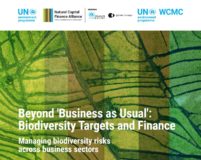
Bron
UNEP FI
New research published today by the United Nations Environment Programme (UNEP) and the Natural Capital Finance Alliance (NCFA), shines a spotlight on the urgent need for financial sector action on biodiversity. The report, entitled ‘Beyond Business as Usual: Biodiversity Targets and Finance‘ highlights the need for banks, investors and insurers to set firm targets to reduce biodiversity loss, for example ‘net positive impact’ across their activities, starting with nine critical sectors where financial players are exposed through their loans, investments or underwriting activities.
- US$44 trillion of economic value generation, more than half the world’s GDP, is moderately or highly dependent on nature, which is under increasing threat
- Banks, investors and insurers have made progress on setting climate and sustainability targets, but few have begun to address biodiversity loss
- The UN-backed group sets out a step-by-step approach for financial institutions to contribute to halting biodiversity loss by setting targets to guide activity
- Mining, Agriculture and Oil & Gas among the nine high priority sectors, along with Brewers and Apparel, Accessories and Luxury Goods
Biodiversity – the variation of species and genetics among animals, plants, fungi or microorganisms – is fundamental to economic health, yet in less than three generations, human-caused global change has accelerated sharply, altering almost 75% of our planet’s surface, from land to ocean, and posing a considerable risk of changing the Earth’s systems. The continued degradation of these vital ecosystem services represents an annual loss of at least US$479 billion per year.
“The COVID-19 pandemic is a stark reminder of our exposure to and the risks created by the loss of nature. We urgently need all sectors of the economy to create better outcomes for people and nature. This report shows that banks, investors and insurers have a crucial part to play too. By making nature part of its decisions, and setting ambitious targets for biodiversity, the financial sector can reduce its risks and help to build a more resilient economy,” said Corli Pretorius, Deputy Director, UN Environment Programme World Conservation Monitoring Centre (UNEP-WCMC)
Eric Usher, Head of UN Environment Programme Finance Initiative (UNEP FI), said, “The emergence of COVID-19 has underscored the fact that, when we destroy biodiversity, we put our lives, livelihoods and economies at risk. This report provides a pathway for financial institutions to build back better and contribute to halting and reversing the biodiversity crisis, enabling them to bring their assets and decision-making in line with global policy developments.”
Policy frameworks, such as the Post-2020 Global Biodiversity Framework, due to be agreed under the Convention on Biological Diversity in 2021, and the European Union’s 2030 Biodiversity Strategy, are placing biodiversity at the heart of a post-pandemic economic recovery.
But, the report argues, these policy goals will be impossible to achieve unless financial institutions consider biodiversity, and urgently set targets to halt, or better reverse, current rates of ecosystem degradation and species loss. While many financial institutions have set climate targets in recent years, few have begun to address the critical issue of biodiversity loss. Significant attention is paid to the financial sector’s consideration of biodiversity, including a recent investigation by the NGO ShareAction, which found that none of the world’s 75 largest asset managers has a dedicated policy on biodiversity.
This may be set to change. The European Commission, for example, is currently reviewing the reporting obligations of businesses under the Non-Financial Reporting Directive, with a view to potentially mandating new disclosures on biodiversity.
Karin Siegwart, Vice-Director of the Swiss Federal Office for the Environment, said, “Improving the understanding of industries’ exposure to biodiversity risks as well as their impact on biodiversity loss allows for better-informed decision-making. This is why we support the development of the enhanced ENCORE tool as it helps align financing and investment decisions with international biodiversity goals.”
Today’s report – developed by the UN Environment Programme World Conservation Monitoring Centre (UNEP-WCMC – explores how financial institutions can contribute to halting biodiversity loss. It sets out the nine priority sectors with large financial flows and major potential dependencies or impacts on biodiversity. This enables financial institutions to gain an understanding of where the highest risks lie within their current activities to inform their target setting.
A step-by-step guide outlines approaches to target-setting on biodiversity based on an initial analysis of the nine priority sectors, with example targets including “no net loss” or “net gain” of biodiversity. These can be implemented through measures such as investing in ecosystem restoration, biodiversity conservation, and the sustainable use of natural resources. This approach enables financial institutions to reduce risk exposure and create a more resilient global economy.
“The nature crisis is accelerating. This is an existential threat to us all – and is already creating profound systemic risks for the global finance sector. Establishing evidence-based biodiversity targets is a basic and essential step for any financial institution that does not want to get left behind. This report – and the innovative ENCORE data platform that sits behind it – is an important step towards that,” said Niki Mardas, Executive Director of Global Canopy
The report draws on the science and analyses of the online ENCORE tool – Exploring Natural Capital Opportunities, Risks and Exposure – developed jointly by the NCFA and UNEP-WCMC. It will be followed later this year by a ground-breaking biodiversity module in ENCORE, currently under development in consultation with 27 financial institutions. The module will enable banks, insurers and investors to assess whether their portfolios are in alignment with global biodiversity goals.



